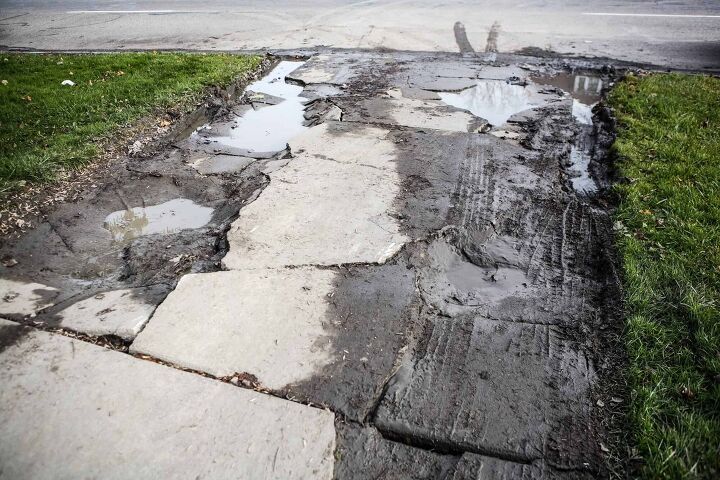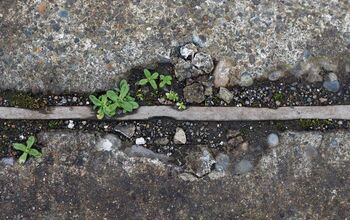How To Fix A Muddy Driveway (In A Few Easy Steps)

One downside of a wet climate is that dirt turns into mud, which can damage cars and dirty up houses. This doesn’t bode well for dirt roads or driveways primarily made up of soil and gravel. Luckily though, there are ways to fix your muddy driveway.
To fix a muddy driveway, you will first have to clear away the mud and dig a drainage ditch to redirect water in the future. Then, lay down some water-resistant materials like geotextile cloth or permeable paver. Finally, lay down new gravel or dirt.
In this how-to guide, we will go through every step of fixing a muddy driveway. We have also provided a few quick fixes if you need to fix your driveway in a pinch.
Do You Need Concrete, Brick, or Stone Pros?
Get free, zero-commitment quotes from pro contractors near you.

Why is There So Much Mud in My Driveway?
After heavy amounts of rainfall, you may experience water puddling in particular areas of your driveway. Depending on your particular situation, this likely has to do with low areas that require elevating.
Filling these low spots with aggregate, like small stones, may be all your driveway needs. Although the process is tedious, it is a relatively easy home improvement project for the average homeowner to perform.
On the other hand, if you notice that your driveway seems to be always underwater, the issue may be with drainage. Waterlogging happens when excess water is unable to run off. Therefore, it settles on your driveway, creating a muddy disarray.
Step One: Clear Gravel and Excess Mud
The first step to fixing a muddy driveway is getting rid of the stickiest, deepest parts of the mud. By clearing this debris, you can get a good look at the state of the driveway underneath it. From there, you will be able to assess areas that need to be filled in.
Once you have cleared the excess debris, you can see if there are any deep holes. If there are, you will need to dig them out and fill them. If any gravel was included in your excess mud, you can use it to fill up these holes.
It’s important to make sure that your driveway’s surface is as level as it can be before you move on. This will ensure that you don’t end up with more holes in the long run. The flatter the surface is, the better it will take the new paving materials.
Step Two: Dig A Drainage Ditch
This step is important if your driveway is on a hill and can be incredibly effective in keeping it dry. By digging a drainage ditch, you can direct any excess water off the driveway and out to the street. This will help keep mud from forming and causing further problems down the line.
Dig the drainage ditch at the high end of the driveway to redirect water away from the flow of downhill. This will keep water from accumulating in the middle and turning the dirt into mud. You can then direct it wherever you like.
Make sure that wherever you are directing the flow of water will not also flood. If there is drain at the bottom of your driveway, redirect it there. For extra flood protection, install a drainage pump in your yard.
Step Three: Lay Down Geotextile Cloth
Geotextile cloth is a specially designed sheet of synthetic polymers designed to hold soil together. Once you have cleared your driveway and made sure it is even, you can lay this down over it. It will ensure that you have a stable base to lay new gravel or dirt onto.
There are two types of geotextile cloth:
- Woven Geotextiles – The geotextiles are woven together and possess an incredible amount of tensile strength. They are ideal for holding together loose soil and lasting a long time. They are, however, pricey due to their intricate weaving.
- Non-Woven Geotextiles – These have a consistency closer to felt and can be a little bit cheaper. However, their lower price means they do not hold soil together as well or for as long.
Step Four: Lay Down New Gravel
After your geotextile cloth has been installed and is holding the dirt together, you can lay down new gravel. This gravel will help with water runoff and help direct any excess water to your drainage ditch.
The best practice for a water-resistant gravel driveway is to start with bigger and end smaller. Large, clean, crushed up rock will provide a solid base. The small gravel will help fill in any gaps and smooth it out.
This smaller gravel is called clean minus rock and is perfect for gravel driveways. It packs down and distributes evenly as you park and drive on it. Basalt is the most popular type of gravel for this application because it packs the tightest.
Step Five: Install a Permeable Paver
Permeable pavers are paving systems that are specifically designed for wet climates. They are porous and allow the water to penetrate the top surface and get to the rock underneath. If you have installed your gravel correctly, this will properly drain out.
Permeable pavers have open areas that are filled with gravel to let the water run through to the base underneath. The number one cause of mud on a dirt or gravel driveway is standing water. If the water can’t go anywhere, it will sit on the surface and cause mud.
There are many grades of permeable pavers from cement to plastic. Depending on how you use your driveway, you may want to invest in heavier-duty pavers. Even though they are more expensive, they are still cheaper than finishing your driveway in asphalt.
Quick Fixes
The above steps are the most comprehensive fix you can perform for a muddy driveway. If you don’t have the time, resources, or energy to completely redo it, there are quick fixes that could hold you over in the meantime.
Cat Litter
Cat litter can be used for more than just a cat’s bathroom. Any home mechanic knows that cat litter is perfect for cleaning up a wide variety of spills on a cement floor. Luckily, the same principle applies for soaking up extra moisture on the driveway. It is a relatively inexpensive drying agent that is easy to apply to the affected areas of your driveway.
To apply, just sprinkle the cat litter wherever you see excess water. If you make sure to get the kind of cat litter that clumps up, it will make the clean up easier. Leaving the clumped up litter will just make more mud.
Note: Though it may be tempting to recycling some of your cat’s old litter, only use clean litter for this method. The scent of dirty little may attract stray cats to your yard.
Hole Patching
One way to stop the spread of mud holes in your driveway is to patch holes as they appear. This will require you to be extra vigilant and maintain them on a daily basis. However, it is an effective way to keep potholes from forming.
As you see holes beginning to appear, fill them with small, crushed stone. Make sure that the hole is completely empty of water before you fill it. If you fill the hole with water in it, you could end up with water pockets which create more potholes.
Lime
Lime is an inorganic material that works with dirt and water to harden up soil. By mixing lime (in the form of either hydrated lime or quicklime), with the dirt in your driveway, it will use any excess water as a hardening agent and dries up wet soil quickly. This makes it much more durable since the rain is then working to protect it.
If you make a mixture by combining lime with dirt and sand, you can finish your whole driveway. This finish will be incredibly strong and help prevent potholes and ruts that can be potentially harmful.
Both quicklime and hydrated lime are known to be incredibly effective at drying out wet silt and clay soils. In fact, highway and building contractors use this method to help expedite their construction projects in rainy weather. Not to mention, it’s a low-cost solution, when compared to other alternative methods.
Do You Need Concrete, Brick, or Stone Pros?
Get free, zero-commitment quotes from pro contractors near you.

Related Questions
Can you put gravel over mud?
While simply dumping gravel over your muddy driveway seems like it would work, it won’t fix the problem. The new gravel will sink into the mud and you’ll be back where you started. This is why it is imperative that you clear any excess mud before laying down new gravel.
How do you fix a waterlogged lawn?
If you are encountering a similar problem with your lawn, maintenance is key. Tilling the soil on the lawn will help drain excess water. Raking and mowing regularly helps keep flowing water from getting trapped and flooding.
Do I need drainage for my driveway?
In short, yes, all driveways require proper drainage to avoid excess water and muddy surfaces. You can achieve appropriate drainage by installing permeable surfaces or a drainage system when your driveway is initially installed.

We are a team of passionate homeowners, home improvement pros, and DIY enthusiasts who enjoy sharing home improvement, housekeeping, decorating, and more with other homeowners! Whether you're looking for a step-by-step guide on fixing an appliance or the cost of installing a fence, we've here to help.
More by Upgraded Home Team



























